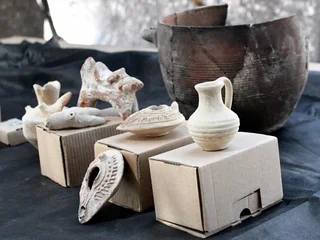Early Islamic mansion with unique subterranean complex discovered in Israel

A luxurious estate from the Early Islamic period, built in the eighth or ninth century but originally styled in Roman-Byzantine fashion, has been discovered in southern Israel, the Israel Antiquities Authority announced Tuesday.
Perhaps the tastes of its owners over the years changed since the original construction about 1,200 years ago, or perhaps social norms did. During the Abbasid period, the brightly coloured frescoes formerly decorating the walls were plastered over in white, the archaeologists found. They even unearthed bits of the walls with white coating over the original images.
Glimpses at ancient sensibilities in archaeology are captivating but the truly remarkable thing about this domain was discovered below ground, after digging 6 meters (nearly 20 feet) down during the salvage excavation ahead of building a new neighbourhood in the Bedouin city of Rahat, in the northern Negev.

Most of the ancient house, which was a huge 30 by 30 meters in size, is gone. Of the original walls, at most half a meter in height remains standing. But beneath that, the archaeologists found a system of subterranean vaulted chambers 2.5 meters in height, built of local limestone blocks. The chambers with their arched ceilings were connected by tunnels also constructed out of stone blocks. The team also found a large cistern at least 3.5 meters in depth carved into the bedrock.
It lay between two ancient mosques, the team adds.
Nothing like it has been found in the Negev before, say Dr. Noé D. Michael, construction director of the excavation on behalf of the IAA together with Oren Shmueli and Dr. Elena Kogan-Zehavi. Similar buildings, practically castles, have been found in Jordan, Michael adds, but not here.
Next door, literally 5 to 10 meters from this manse, was a farmhouse, Michael says, adding that it seems to have been built first.

That said, at this stage there are more questions than answers. To whom did all this belong? Did a farmer strike it rich and build a mansion? Or maybe it belonged to a local chief? Were the farm and mansion even related – they did operate contemporaneously and who would want a complete stranger farming within spitting distance of one’s mansion? What purpose did these beautifully built underground arched chambers serve?
What can be said, Michael explains, is that other complexes in the Negev also have subterranean chambers, i.e., medieval basements, but they weren’t gorgeously built using stone blocks; they were crudely cut out of into the loess, which is the soft sedimentary rock typical of this area. Building these chambers beneath the house would have been expensive and demanded heavy investment, not only in materials but in competent architects, Michael says.
“They excavated six meters down to the bedrock and erected arches and tunnels in all directions, and in the bedrock they carved the cistern going down at least 3.5 meters. It was a technological feat,” he says, adding that the archaeologists cannot pursue the excavation even deeper at this stage until receiving the blessing of engineers that it’s safe.
And in one tunnel they also found a Seal of Solomon – today known as a Star of David – which does not mean there were Jews there. The Seal of Solomon adorned many mosques of the period, and churches too, Michael explains. Islam recognizes Solomon as a powerful prophet and the symbol served to discourage the evil eye.
As said, aboveground not much remains. But the archaeologists can tell the house had been constructed in typical Middle Eastern style, with four wings emanating from a central courtyard. Some houses even had two courtyards, Michael observes. One wing had a hall paved with marble.
Marble does not exist locally and had to have been imported – but not at this time. It had been “lifted” from a church or monastery, Michael says. “We have a lot of marble finds in this house that were clearly taken from a Christian context,” he says – for instance, a cross could still be seen
Repurposing stone, especially precious marble, is very common but one thing that wasn’t usual at all, in the early Islamic period in the Negev, was frescoes. What they showed is anybody’s guess at this point; perhaps at a later stage researchers can piece together fragments and get a glimpse at the ancient, and then scorned, images, which were done in stark colours – blue, red, yellow and black.
Other rooms in the building had plaster floors, which was certainly the norm, and the archaeologists also found “very large ovens – probably for cooking.”
Which means, they found no indication of what the ovens had been used for: no slag from glass or metal production, no shattered clay from kilns. Some were clay taboons that were probably used for food preparation.
They also found the ruins of a tower in the southwest corner, which could have served for security guards or just to monitor the fields. One could oversee that workers were working and nobody was stealing the animals without bothering to actually go there, Michael suggests.
Finally, one must speculate what purpose these beautiful underground rooms served. At least some were likely for storage, Michael says, but he doesn’t rule out the possibility that people also spent time there – they had water right there in the cistern, he points out: the opening to that water storage chamber is below the vaulted rooms.
And if they did choose to spend time down there, possibly to avoid the blistering heat of the Negev summer, they weren’t squatting in the dark on dirt floors. No, clay lamps were found down there, and flooring. This was a house of people who lived in style, even if their taste in wall décor changed.




